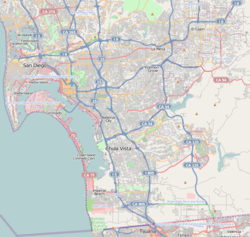| U.S. Inspection Station/U.S. Custom House | |
| U.S. National Register of Historic Places | |
 U.S. Custom House in 1981, looking north at the west and south façades U.S. Custom House in 1981, looking north at the west and south façades | |
 | |
| Location | Virginia and Tijuana Sts., San Ysidro, California |
|---|---|
| Coordinates | 32°32′34″N 117°01′41″W / 32.5428°N 117.028°W / 32.5428; -117.028 |
| Area | less than one acre |
| Architect | Office of the Supervising Architect under James A. Wetmore |
| Architectural style | Mission/Spanish Revival |
| NRHP reference No. | 83001228 |
| Added to NRHP | February 10, 1983 |


The United States Custom House (also known as the Old Customs House) in San Ysidro, San Diego, California, is a 1933 Spanish Revival–style building located 50 feet (15 m) north of the Mexico–United States border at the San Ysidro Port of Entry. It is listed on the National Register of Historic Places with the full historic name U.S. Inspection Station/U.S. Custom House and common name U.S. Custom House.
History
The Custom House was part of a large federal building program begun in 1926 during the Herbert Hoover administration in which 1,300 new federal buildings were constructed. The building was designed by the Supervising Architect's office of the Treasury Department; construction was performed by Robert E. McKee of El Paso, Texas, who was paid $93,800. Groundbreaking was in early summer 1932. In May 1933 the building was complete; it was quietly put into use without a formal dedication ceremony.
As traffic increased at the crossing over the decades, an additional building was added north of the 1933 facility. That new building was then replaced by much larger inspection and customs facilities to its west, completed in 1974 and still in use. After a period during which the ground floor of the Custom House was left empty, the ground floor once again houses offices of U.S. Immigration and Customs Enforcement (ICE).
Significance
The building is considered important for two reasons, one political and one architectural. Politically, the building has played an important symbolic role in relations between Mexico and the United States at one of the busiest land border crossings in the world. Architecturally, it is considered a locally prominent example of the Spanish Colonial Revival architectural style as applied to a public building.
References
- "National Register Information System". National Register of Historic Places. National Park Service. July 9, 2010.
- ^ "San Ysidro Land Port of Entry Improvements Project Draft Supplemental Environmental Impact Statement Volume I", U.S. General Services Administration
- ^ Nomination form Archived 2014-07-14 at the Wayback Machine for the National Register of Historic Places for the U.S. Inspection Station/U.S. Custom House, National Park Service
- "Community Profiles: San Ysidro". City of San Diego. Retrieved June 14, 2014.
- Dibble, Sandra (July 11, 2010). "Number of border crossings stabilizes". San Diego Union Tribune. Retrieved June 14, 2014.
| Mexico–United States border at San Diego–Tijuana | ||
|---|---|---|
| Border crossing facilities |   | |
| Buildings and facilities on the border | ||
| Communities and areas | ||
| Authorities | ||
| Related | ||
| U.S. National Register of Historic Places | |
|---|---|
| Topics | |
| Lists by state |
|
| Lists by insular areas | |
| Lists by associated state | |
| Other areas | |
| Related | |
- Buildings and structures in San Diego
- Buildings and structures completed in 1933
- Custom houses in the United States
- National Register of Historic Places in San Diego
- Mission Revival architecture in California
- Custom houses on the National Register of Historic Places
- Government buildings on the National Register of Historic Places in California